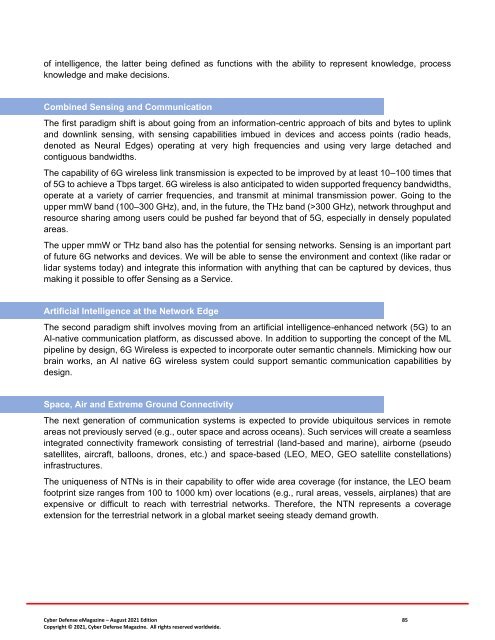Cyber Defense eMagazine August Edition for 2021
Cyber Defense eMagazine August Edition for 2021 #CDM #CYBERDEFENSEMAG @CyberDefenseMag by @Miliefsky a world-renowned cyber security expert and the Publisher of Cyber Defense Magazine as part of the Cyber Defense Media Group as well as Yan Ross, US Editor-in-Chief, Pieruligi Paganini, Co-founder & International Editor-in-Chief, Stevin Miliefsky, President and many more writers, partners and supporters who make this an awesome publication! Thank you all and to our readers! OSINT ROCKS! #CDM #CDMG #OSINT #CYBERSECURITY #INFOSEC #BEST #PRACTICES #TIPS #TECHNIQUES
Cyber Defense eMagazine August Edition for 2021 #CDM #CYBERDEFENSEMAG @CyberDefenseMag by @Miliefsky a world-renowned cyber security expert and the Publisher of Cyber Defense Magazine as part of the Cyber Defense Media Group as well as Yan Ross, US Editor-in-Chief, Pieruligi Paganini, Co-founder & International Editor-in-Chief, Stevin Miliefsky, President and many more writers, partners and supporters who make this an awesome publication! Thank you all and to our readers! OSINT ROCKS! #CDM #CDMG #OSINT #CYBERSECURITY #INFOSEC #BEST #PRACTICES #TIPS #TECHNIQUES
Create successful ePaper yourself
Turn your PDF publications into a flip-book with our unique Google optimized e-Paper software.
of intelligence, the latter being defined as functions with the ability to represent knowledge, process<br />
knowledge and make decisions.<br />
Combined Sensing and Communication<br />
The first paradigm shift is about going from an in<strong>for</strong>mation-centric approach of bits and bytes to uplink<br />
and downlink sensing, with sensing capabilities imbued in devices and access points (radio heads,<br />
denoted as Neural Edges) operating at very high frequencies and using very large detached and<br />
contiguous bandwidths.<br />
The capability of 6G wireless link transmission is expected to be improved by at least 10–100 times that<br />
of 5G to achieve a Tbps target. 6G wireless is also anticipated to widen supported frequency bandwidths,<br />
operate at a variety of carrier frequencies, and transmit at minimal transmission power. Going to the<br />
upper mmW band (100–300 GHz), and, in the future, the THz band (>300 GHz), network throughput and<br />
resource sharing among users could be pushed far beyond that of 5G, especially in densely populated<br />
areas.<br />
The upper mmW or THz band also has the potential <strong>for</strong> sensing networks. Sensing is an important part<br />
of future 6G networks and devices. We will be able to sense the environment and context (like radar or<br />
lidar systems today) and integrate this in<strong>for</strong>mation with anything that can be captured by devices, thus<br />
making it possible to offer Sensing as a Service.<br />
Artificial Intelligence at the Network Edge<br />
The second paradigm shift involves moving from an artificial intelligence-enhanced network (5G) to an<br />
AI-native communication plat<strong>for</strong>m, as discussed above. In addition to supporting the concept of the ML<br />
pipeline by design, 6G Wireless is expected to incorporate outer semantic channels. Mimicking how our<br />
brain works, an AI native 6G wireless system could support semantic communication capabilities by<br />
design.<br />
Space, Air and Extreme Ground Connectivity<br />
The next generation of communication systems is expected to provide ubiquitous services in remote<br />
areas not previously served (e.g., outer space and across oceans). Such services will create a seamless<br />
integrated connectivity framework consisting of terrestrial (land-based and marine), airborne (pseudo<br />
satellites, aircraft, balloons, drones, etc.) and space-based (LEO, MEO, GEO satellite constellations)<br />
infrastructures.<br />
The uniqueness of NTNs is in their capability to offer wide area coverage (<strong>for</strong> instance, the LEO beam<br />
footprint size ranges from 100 to 1000 km) over locations (e.g., rural areas, vessels, airplanes) that are<br />
expensive or difficult to reach with terrestrial networks. There<strong>for</strong>e, the NTN represents a coverage<br />
extension <strong>for</strong> the terrestrial network in a global market seeing steady demand growth.<br />
<strong>Cyber</strong> <strong>Defense</strong> <strong>eMagazine</strong> – <strong>August</strong> <strong>2021</strong> <strong>Edition</strong> 85<br />
Copyright © <strong>2021</strong>, <strong>Cyber</strong> <strong>Defense</strong> Magazine. All rights reserved worldwide.


















